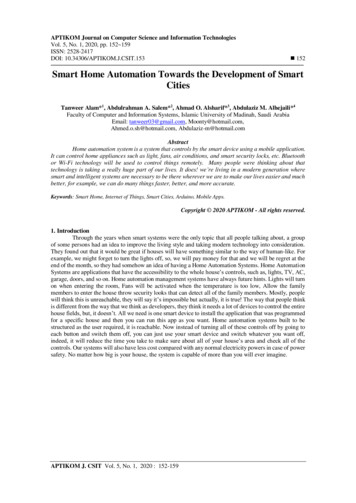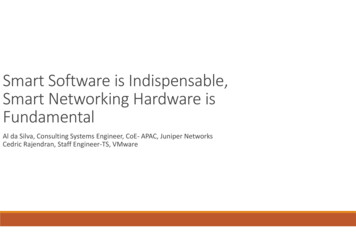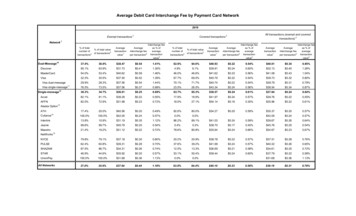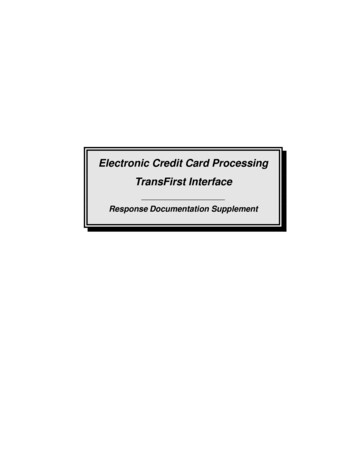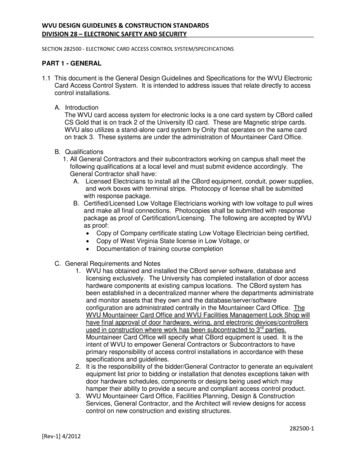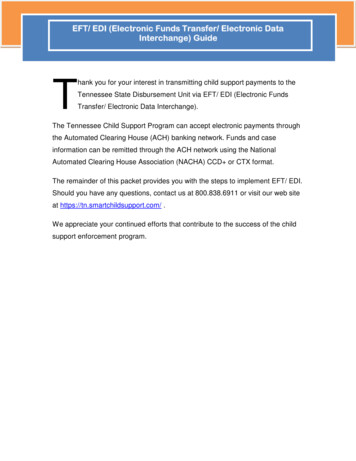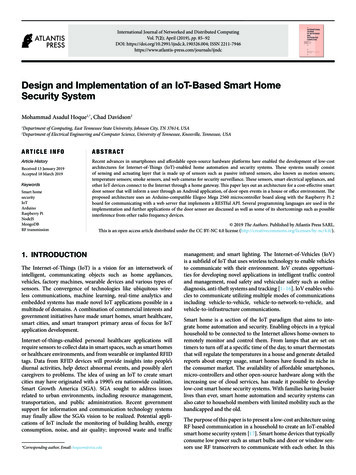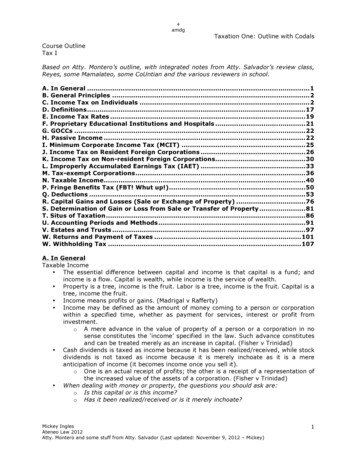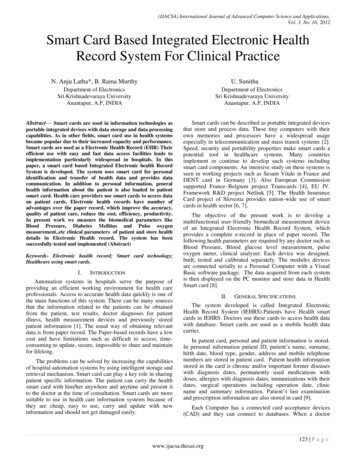
Transcription
(IJACSA) International Journal of Advanced Computer Science and Applications,Vol. 3, No. 10, 2012Smart Card Based Integrated Electronic HealthRecord System For Clinical PracticeN. Anju Latha*, B. Rama MurthyU. SunithaDepartment of ElectronicsSri Krishnadevaraya UniversityAnantapur, A.P, INDIADepartment of ElectronicsSri Krishnadevaraya UniversityAnantapur, A.P, INDIAAbstract— Smart cards are used in information technologies asportable integrated devices with data storage and data processingcapabilities. As in other fields, smart card use in health systemsbecame popular due to their increased capacity and performance.Smart cards are used as a Electronic Health Record (EHR) Theirefficient use with easy and fast data access facilities leads toimplementation particularly widespread in hospitals. In thispaper, a smart card based Integrated Electronic health RecordSystem is developed. The system uses smart card for personalidentification and transfer of health data and provides datacommunication. In addition to personal information, generalhealth information about the patient is also loaded to patientsmart card. Health care providers use smart cards to access dataon patient cards. Electronic health records have number ofadvantages over the paper record, which improve the accuracy,quality of patient care, reduce the cost, efficiency, productivity.In present work we measure the biomedical parameters likeBlood Pressure, Diabetes Mellitus and Pulse oxygenmeasurement.,etc clinical parameters of patient and store healthdetails in Electronic Health record. The system has beensuccessfully tested and implemented (Abstract)Keywords- Electronic health record; Smart card technology;Healthcare using smart cards.I.INTRODUCTIONAutomation systems in hospitals serve the purpose ofproviding an efficient working environment for health careprofessionals. Access to accurate health data quickly is one ofthe main functions of this system. There can be many sourcesthat the information related to the patients can be obtainedfrom the patient, test results, doctor diagnoses for patientillness, health measurement devices and previously storedpatient information [1]. The usual way of obtaining relevantdata is from paper record. The Paper-based records have a lowcost and have limitations such as difficult to access, timeconsuming to update, secure, impossible to share and maintainfor lifelong.The problems can be solved by increasing the capabilitiesof hospital automation systems by using intelligent storage andretrieval mechanism. Smart card can play a key role in sharingpatient specific information. The patient can carry the healthsmart card with him/her anywhere and anytime and present itto the doctor at the time of consultation. Smart cards are moresuitable to use in health care information systems because ofthey are cheap, easy to use, carry and update with newinformation and should not get damaged easily.Smart cards can be described as portable integrated devicesthat store and process data. These tiny computers with theirown memories and processors have a widespread usageespecially in telecommunication and mass transit systems [2].Speed, security and portability properties make smart cards apotential tool in healthcare systems. Many countriesimplement or continue to develop such systems includingsmart card components. An intensive study on these systems isseen in working projects such as Sesam Vitale in France andDENT card in Germany [3]. Also European Commissionsupported France–Belgium project Transcards [4], EU IV.Framework R&D project Netlink [5]. The Health InsuranceCard project of Slovenia provides nation-wide use of smartcards in health sector [6, 7].The objective of the present work is to develop amultifunctional user-friendly biomedical measurement deviceof an Integrated Electronic Health Record System, whichprovides a complete e-record in place of paper record. Thefollowing health parameters are required by any doctor such asBlood Pressure, Blood glucose level measurement, pulseoxygen meter, clinical analyzer. Each device was designed,built, tested and calibrated separately. The modules devicesare connected serially to a Personal Computer with a VisualBasic software package. The data acquired from each systemis then displayed on the PC monitor and store data in HealthSmart card [8].II.GENERAL SPECIFICATIONSThe system developed is called Integrated ElectronicHealth Record System (IEHRS).Patients have Health smartcards in IEHRS. Doctors use these cards to access health datawith database. Smart cards are used as a mobile health datacarrier.In patient card, personal and patient information is stored.In personal information patient ID, patient’s name, surname,birth date, blood type, gender, address and mobile telephonenumbers are stored in patient card. Patient health informationstored in the card is chronic and/or important former diseaseswith diagnosis dates, permanently used medications withdoses, allergies with diagnosis dates, immunizations with theirdates, surgical operations including operation date, clinicname and summary information. Patient’s last examinationand prescription information are also stored in card [9].Each Computer has a connected card acceptance devices(CAD) and they can connect to databases. When a doctor123 P a g ewww.ijacsa.thesai.org
(IJACSA) International Journal of Advanced Computer Science and Applications,Vol. 3, No. 10, 2012inserted a card in CAD patient’s health data are displayed[10]. After examination, doctor updates inspection andprescription information on patient smart card with new data.Hospital administration unit to record new inspection andprescription data stored on smart card. The hospitaladministration manage hospital database as well as the otherresponsibilities of administration is to record new patients tosystem and to perform smart card related operations like smartcard preparation for new users and data update from smartcards to database and database to smart cards[11].III.SYSTEM DESCRIPTION- IEHRS BLOCK DIAGRAM &DESCRIPTIONThe Integrated Electronic Health Record System (IEHRS)block diagram as shown in figure 1. The primary function ofthe device is to operate as a medical pre-screening/diagnosticdevice. The first stage lists the four different types of medicaldata to be measured by the device. Blood Pressure, BloodGlucose, Pulse Oxymeter and clinical analyzer. In the secondstage of the system a Personal Computer reads data from thesemedical devices and stores it in a specified patient database. Inthe third stage the stored data is transferred to a health smartcard using smart card reader/ writer to create an e-record.thegraphical user interface package has developed using VisualBasic for the present work integrated electronic health recordsystem.range of hardware. The blood pressure measurements weretested and the results are shown in Table 1.TABLE 1: Measured Blood Pressure values . Blood Sugar Level MeterGlucose is one of the body’s main sources of energy.Diabetes is a chronic metabolic disorder characterized by ahigh concentration of sugar in the blood. Diabetes mellitus isa condition in which the pancreas no longer produces enoughinsulin or when cells stop responding to the insulin that isproduced, so that glucose in the blood cannot be absorbed intothe cells of the body. The body maintains blood glucose levelswithin a narrow range (70-130mg/dl).In the present design, a microcontroller based system forthe measurement of blood glucose is designed and developed.It is based on the Amperometric method. A PIC 18F4520microcontroller is used in the present study. LCD module isused to display measured values of blood glucose. TheMAX232 is a dual line driver/receiver, converts signals forman RS-232 serial port to TTL compatible signals is interfacedwith the microcontroller. Software is developed in C languageusing MPLAB IDE for the Microchip Technology. The bloodglucose measurements were tested and the results are shown inTable 2.TABLE 2: Measured Blood Glucose values (mg/dl)Figure 1: Block Diagram of Integrated Electronic Health Record SystemIV.HARDWAREA. Blood Pressure MeterBlood pressure is the force exerted by circulating blood onthe walls of blood vessels. BP is the force created by the heartas it pushes blood into the arteries through the circulatorysystem. A typical reading will look like ―120/80‖ and ismeasured in mmHg. The upper value is the Systolic BloodPressure, and the lower value is the Diastolic Blood Pressure.In the present study, a microcontroller MCF51QE128basedsystem for the measurement of blood pressure is developed.Further, an LCD module to display the data of systolic anddiastolic blood pressure and MR2A16A asynchronousmagneto resistive RAM to store measured values of systolicdiastolic pressure values are interfaced with themicrocontroller, which reduces the hardware complexity.Software is developed in C language using IAR embeddedwork bench IDE due to the inherent language flexibility, theextent of support and its potential for portability across a wideS. NoOnetouchUltra 182317332Presentmeter131152180321339B. Oxygen Saturation (SaO2)Oxygen saturation level or, SaO2 reveals the amount ofoxygen carried by the blood. A low SaO2 level can indicatethat the body is not getting enough oxygen, and could be asymptom of lung or heart disease. An overly high SaO2 levelcan cause oxygen poisoning. Pulse Oxymeter is based on thefractional change in light transmission during an arterial pulseat two different wavelengths.TABLE 3: Pulse oxygen measurementS.No12345BPL nt MeterPulseOxygen9799999798Pulserate6768716768124 P a g ewww.ijacsa.thesai.org
(IJACSA) International Journal of Advanced Computer Science and Applications,Vol. 3, No. 10, 2012In present design of Pulsoximeter MSP430FG437microcontrolleris used. The pulsoximeter consists of aperipheral probe combined with the MCU displaying theoxygen saturation and pulse rate on LCD glass. The probe isplaced on a peripheral point of the body such as a fingertip,ear lobe or the nose. The probe includes two light emittingdiodes (LEDs), one in the visible red spectrum (660 nm) andthe other in the infrared spectrum (940 nm). The percentage ofoxygen in the body is worked by measuring the intensity fromeach frequency of light after it transmits through the body andthen calculating the ratio between these two intensities. Thepulse oxygen meter measurements values are tested and theresults are shown in Table 3.The above instruments are tested and results are found tobe satisfactory. The instruments are handheld, rugged, lowcost, low energy consumption, wearable and cost effectivecompared to the other commercially available. The measuredvalues are transmitted to a Personal Computer and stored inthe patient database to create an e- recordB. Clinical Chemistry Analyzer - RT1904CClinical chemistry analysis is one of the most importantareas within clinical laboratory analysis. The term clinicalchemistry usually refers to determining the concentration oractivity of a protein, carbohydrate, lipid, electrolyte, enzymeor small molecule in easily-collected bodily fluids such asblood, serum, plasma or urine. However, it is not necessarilylimited to these determinations. In the present design anRT1904C Clinical Chemistry Analyzer is used and themeasurement values of all clinical parameters are transferredto EHR system interfacing with PC through RS-232 withdeveloped IEHRS software package.V.including chief complaint, patient disposition, etc. Thepersonal details contain the personal details, emergency detailsand insurance details of a patient. The emergency detailscontain the blood Group, allergies of a patient. etc., Theinsurance details of a patient consist of a patient insurancepolicy name, number, policy type, date of issue, date of expiryand amount of patient. The Doctor option consists ofConsultation, Discharge Process and Prescription. LaboratorySystem Components consists of integrate orders, results fromlaboratory instruments, schedules, billing and otheradministrative information. In the present work measurementdevices like Blood Pressure meter, Blood Glucose meter,Pulseoxy meter and clinical analyzer have been integrated.The measured devices are communicated with the PersonalComputer by selecting the serial port. The results aretransmitted from the electronic medical device to the PersonalComputer. And further it will be transferred to health smartcard. Pharmacy System Components consists of the patient’sname, number and cost details. The electronic prescribingconsists of the drug details of a patient. Flowchart of thesystem is as shown in fig 2.VI.FLOW CHARTSOFTWAREIn IEHRS we developed exclusive software in VisualBasic for the reading and writing of the health information onto electronic health recording system.The GUI program in Visual Basic is used to communicatewith the medical devices. The code allows us to send andreceive characters over RS232 with SQL support for a userdatabase in which the patient data can be stored securely forusage. The patient database could keep track of medicalcheckup results of patients and are useful in establishinghealth histories and monitoring trends. Periodically, thedatabase can be uploaded to any specialist for furtherdiagnosis, prevention, and treatment. For example, milddiabetics only require blood sugar level monitoring a fewtimes a week. A database can keep track of their blood sugarhistory, revealing trends and help develop a plan forcontrolling their disorder.When a file is opened it displays the menu bar whichconsists of six items having individual functions Reader,EHR Administration, Doctor, Lab and Medical. The Readeroption on the menu consists of Connect, Disc
paper, a smart card based Integrated Electronic health Record System is developed. The system uses smart card for personal identification and transfer of health data and provides data communication. In addition to personal information, general health information about the patient is also loaded to patient smart card. Health care providers use smart cards to access data

